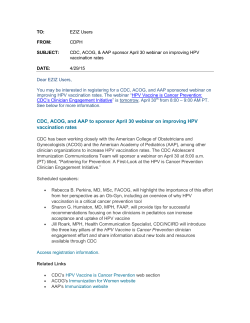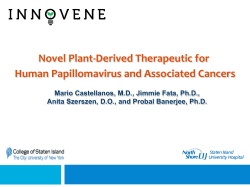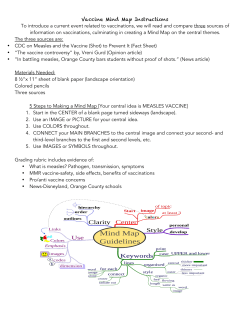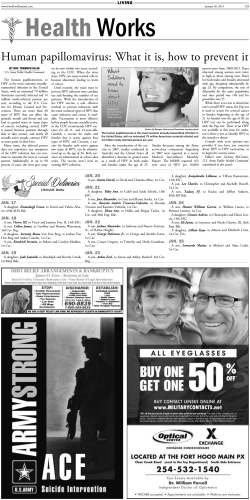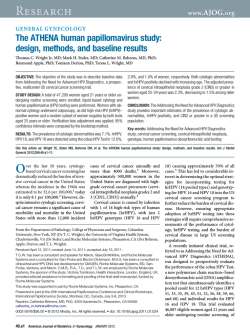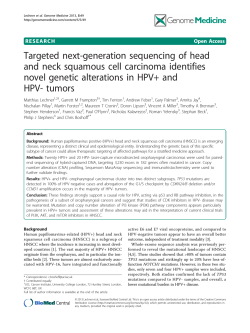
Using Failure Mode and Effects Analysis (FMEA)
Using Failure Mode and Effects Analysis (FMEA) Methods to Identify Barriers Contributing to Low Human Papillomavirus (HPV) Vaccination Rates in a University-Based Community Health Clinic Kelsey Palmer, PharmD1; Nancy Nickman, RPh, PhD1,2; Krystal Moorman, PharmD, BCPS1,3; David Owen, MD3; Diana Brixner, RPh, PhD1,2; Brandon T. Jennings, PharmD, BCACP1,3 , 1 University of Utah College of Pharmacy, Salt Lake City, Utah; 2University of Utah Pharmacotherapy Outcomes Research Center, Salt Lake City, Utah; 3 University of Utah Hospitals and Clinics, Salt Lake City, Utah Vaccine Process Steps Introduction / Background • Approximately 79 million individuals in the US are infected with HPV, with 14 million becoming newly infected each year1 • Utah has the lowest rate of immunization in the US2 • HPV remains one of the most underused vaccines3,4 • Likely due to parental beliefs that HPV is not severe or a discomfort discussing the sexual implications of the vaccine3 • Significantly more parents note safety concerns with the HPV vaccination than with other childhood vaccinations 4 Pre-visit planning (PVP): • Immunizations reviewed and pended for well child check in pediatrics, note made in chart • Immunizations reviewed and pended for well child check in family medicine • No Epic alerts for vaccinations in internal medicine (IM) Rooming the patient (RN or MA): • Patient asked about immunizations when roomed in pediatrics (always for well child check, sometimes for sick visits) • Patient asked about immunizations when roomed for well child check in family medicine Objectives • Conduct an FMEA to identify failure modes that contribute to adolescents not being vaccinated against HPV in a university-based community health clinic • Design and implement a future intervention based on this quality improvement initiative’s results Provider sees patient: • Parent agrees to vaccination • Provider signs orders • After visit summary sometimes provided to patient Methods / Process • • • • • Assemble a multidisciplinary team who provide care for adolescent patients Map all steps in the HPV vaccination process Identify potential failure modes at each step identified Utilize FMEA methods to assign a Risk Priority Number (RPN) to each failure Assign RPN scores based on likelihood of occurrence, likelihood of detection, and ability to correct locally • Failure mode(s) with highest RPN score(s) to be targeted for potential process improvement Vaccine given 2. Correspondence Please address inquiries to: Kelsey Palmer, PharmD, Community Practice Resident University of Utah College of Pharmacy/Bowman’s Pharmacy Kelsey.Palmer@pharm.utah.edu All authors have no relevant conflicts of interest to declare Presented at: APhA Annual Meeting and Exposition; March 27-30, 2015 San Diego, CA 3. 4. Top Failure Modes Likelihood of Likelihood Occurrence of Detection Ability to correct locally RPN Follow-up not scheduled 10 8 10 800 After visit summary not provided to patient 10 8 1092.08% 800 Immunizations not addressed in PVP for IM 9 9 9 729 Immunizations not checked when patient is roomed in IM 9 9 9 729 HPV vaccination not discussed in sick visits 9 9 9 729 Patient is not informed when back in stock 10 8 9 720 Conclusions References 1. Results Human Papillomavirus (HPV). Centers for Disease Control and Prevention website. http://www.cdc.gov/hpv/vaccine.html. Updated February 5, 2013. Accessed August 15, 2014. Elam-Evans LD, Yankey D, Jeyarajah J, et al. National, regional, state, and selected local area vaccination coverage among adolescents aged 13-17 years- United States, 2013. Atlanta (GA): Centers for Disease Control and Prevention. 2014 July 25. MMWR 63(29);625-633. McRee AL, Gilkey MB, Dempsey AF. HPV Vaccine Hesitancy: Findings From a Statewide Survey of Health Care Providers. J Pediatr Health Care. 2014 July 10. Jacobson RM, Roberts JR, Darden PM. Parents’ Perceptions of the HPV Vaccine: A Key Target for Improving Immunization Rates. Expert Rev Clin Immunol. 2013, 9(9):791-793. • Failure modes with highest RPNs are related to incomplete vaccine series • Vaccinations are not frequently addressed in Internal Medicine • Opportunity often missed to discuss vaccinations when pediatric patients present for sick or same-day visits Limitations • Data limited to one community practice site • Practice setting in academic health center could limit generalizability • No pediatrician participation on FMEA team
© Copyright 2025

